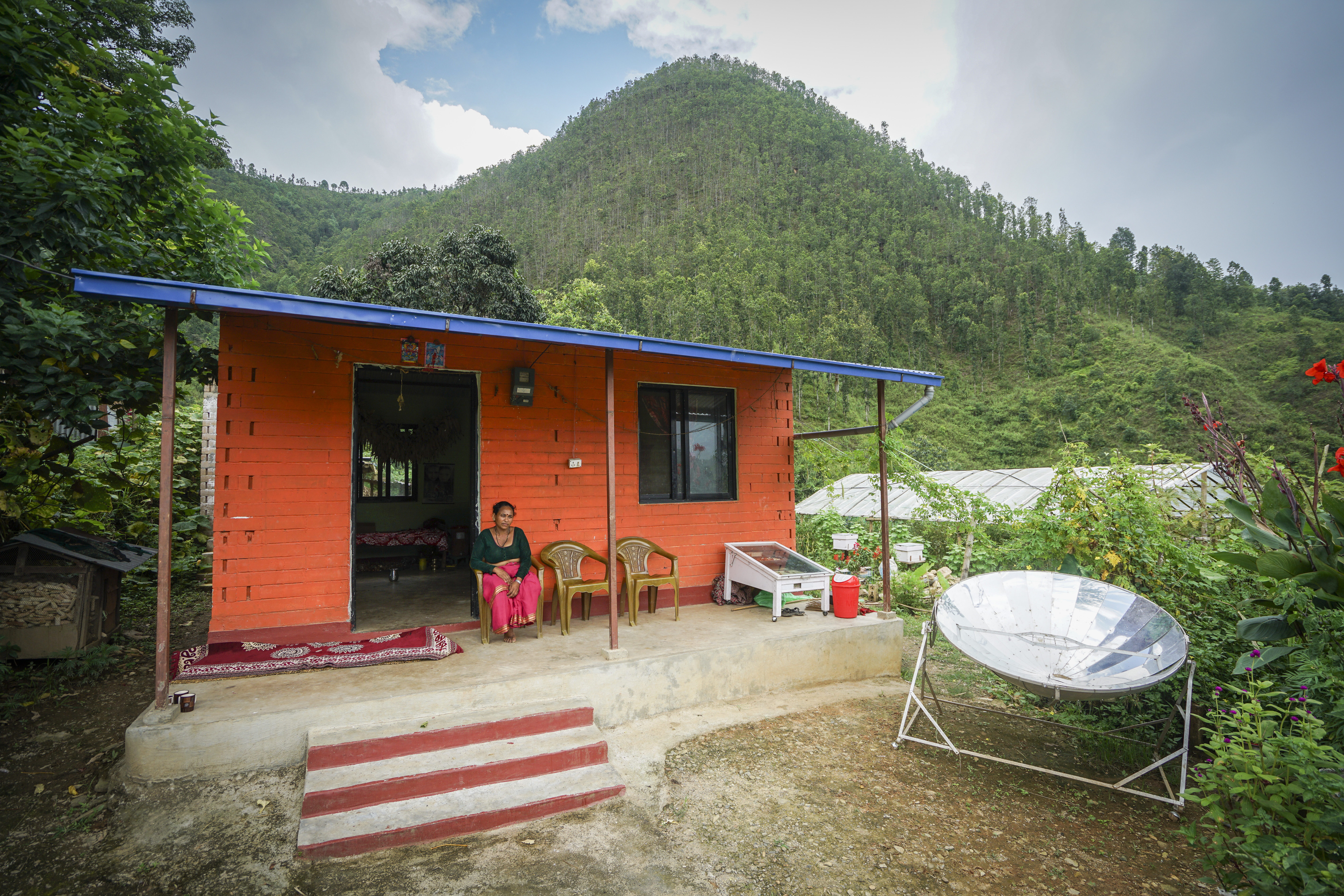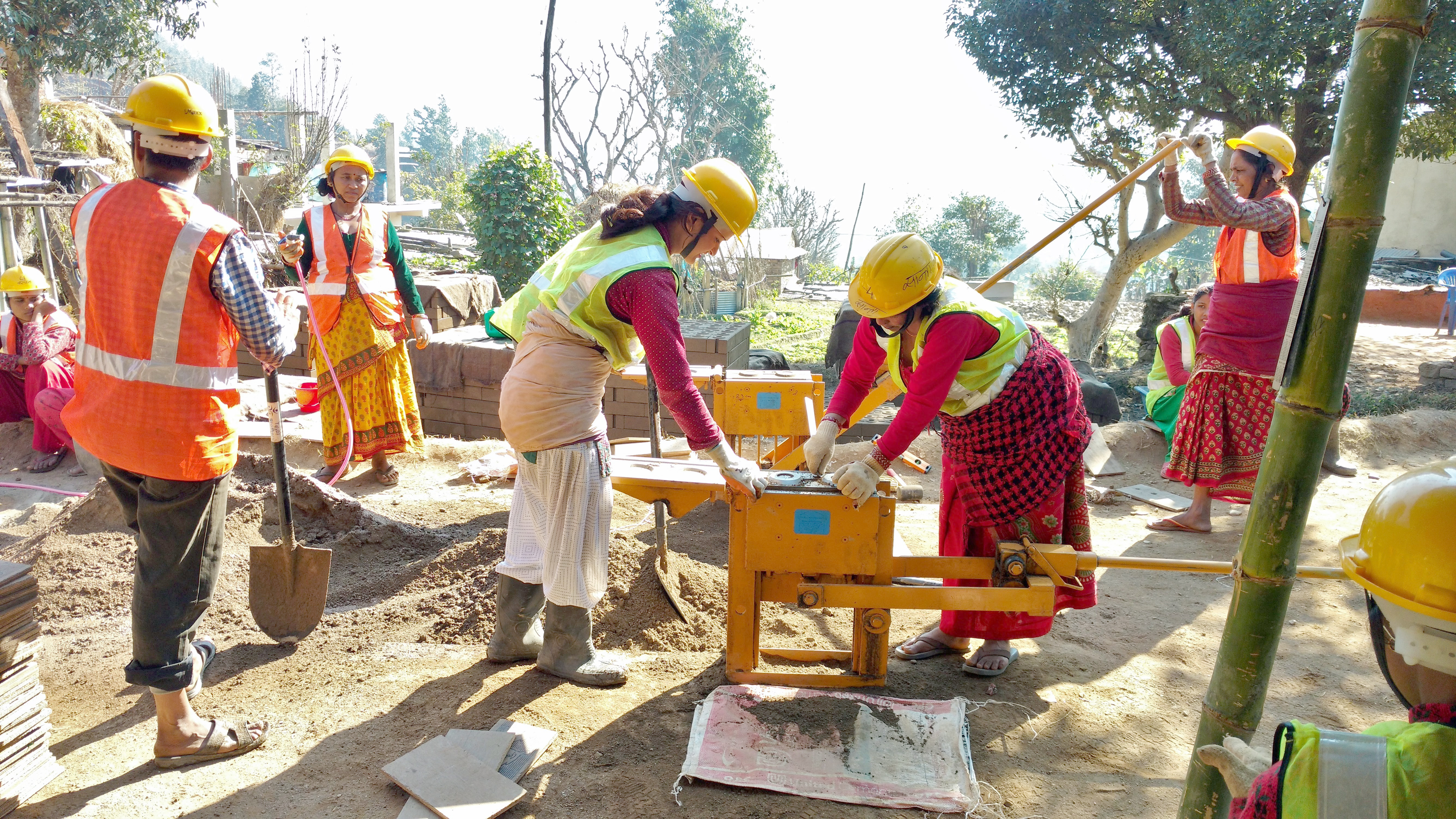Resilient Mountain Village: A Case of Post-Earthquake Reconstruction in Dhungentar, Nuwakot
|
Source:ICIMOD |
Introduction Dhungentar in Nepal’s Nuwakot District was one of many mountain settlements severely affected by the earthquake in 2015. Located on a north–south slope in Bidur Municipality, the village faced multiple hazards: landslides and rockfalls, floods, soil erosion, wildfires, and seismic risk. Most households, dependent on subsistence agriculture, daily wage labour, and traditional crafts, were affected. In this context, a pilot project - Resilient Mountain Village (RMV) [1] - implemented from 2016 to 2018, aimed to build resilient and sustainable infrastructure. Led by ICIMOD in partnership with Nepal’s National Reconstruction Authority (NRA), Innovation Design Concern, Sahayata Samajik Sanstha, and Manushi, and supported by International Development Research Centre (IDRC), the project focused on transport, health, and social infrastructure using a risk-informed, community-driven approach. |
|
Earthquake Resistant Housing Reconstructing 90 houses was a key priority. Fifty-four homes were built using interlocking Compressed Stabilized Soil Blocks (CSSBs) while 36 used reinforced cement concrete (RCC). CSSBs (made from a 1:3:5 mix of cement, sand, and soil) offered a low-carbon alternative to fired bricks, with a tested compressive strength of 2.71 MPa. The earthquake-resistant design incorporated several features. Vertical steel rebars were inserted into hollow blocks or between courses and grouted, connecting walls to the foundation and seismic roof bands. Reinforced concrete bands at plinth, sill, lintel, and roof levels allowed the structure to move as a unit during earthquakes. Low-rise layouts of one to two storeys limit reduced mass and seismic vulnerability, while the CSSB aesthetic reflected vernacular architecture and preserved community identity. Local residents, including women, were trained to produce blocks using a Compacted Intermeshing Block Machine. This approach turned locally available soil to a construction material, creating employment and enterprise opportunities. A multipurpose community hall with a basic health unit was also constructed using CSSBs. Infrastructure and Livelihoods The project also improved connectivity by constructing 1,537 meters of roads, approximately 500 metres of walking trails, and two bridges linking scattered hamlets to markets. New toilets, solar streetlights, and biogas plants improved living conditions. Livelihood activities, including kitchen gardening, soap and incense making, beekeeping, poultry, and animal husbandry, were introduced to diversify household incomes. As non-fired blocks, CSSBs produce roughly 75% fewer emissions and 90% less air pollution than fired bricks[2]. The technology, developed at the Habitech Center at AIT Thailand and tested in Bhutan, Indonesia, Laos, Myanmar, Nepal, Nigeria, Pakistan, and Thailand, demonstrated how risk-informed planning, indigenous knowledge, and ecosystem-sensitive choices can be integrated in a mountain village reconstruction programme. |
|
|
From indigenous and ecosystem-based solutions to advanced early warning systems, CDRI's latest publication - Shaping Resilience in Mountains: The Case for Disaster Resilient Infrastructure[3] - explores how local ingenuity, traditional knowledge, and technological innovation come together to build resilience in mountain regions. Drawing on evidence from diverse mountain contexts, the publication documents proven practices and translates them into actionable recommendations for building disaster resilient infrastructure. |
|
|
CSSB blocks Source: ICIMOD |
|
|
Challenges and Opportunities for Scaling Community acceptance of CSSB technology has grown as residents have seen how interlocking blocks, reinforcement detailing, and seismic bands create earthquake-resistant homes. However, adoption beyond the project area has faced obstacles: distrust of unfamiliar materials, weak supply chains, a 28-day curing period that slows production, and the heavier weight of CSSBs (approximately 6.2 kg per block versus 3.5 kg for fired bricks). The low-rise design also limits future vertical expansion, which can be challenging for growing families. Five-year evaluations revealed that several livelihood initiatives were not fully sustained, highlighting gaps in capacity building, particularly around marketing skills and market linkages. Despite these challenges, the project identified a pathway for scaling. CSSB production can be developed as small- to medium-scale enterprises, supported by blended finance and government incentives for green building materials. Community-led enterprises can serve targeted demand in disaster-prone areas; brick kiln owners can diversify toward CSSBs as coal prices rise; and the modest skill requirements can create employment opportunities for unskilled youth and women. The Dhungentar experience demonstrates that building resilient mountain villages require more than safer, low-carbon infrastructure. They need strong local partnerships, robust technical standards, and market systems that sustain livelihoods long after reconstruction is complete. By: Simran Silpakar, Erica Udas, Abid Hussain, Neera Shrestha Pradhan, and Udayan Mishra - ICIMOD (International Centre for Integrated Mountain Development) The views and opinions expressed in this blog are those of the authors and do not necessarily reflect those of the Coalition for Disaster Resilient Infrastructure (CDRI). Other Resources https://cdri.world/mountains/#resources https://www.icimod.org/dhungentar/ [1] ICIMOD. (2018). Resilient mountain village: A pilot demonstration project on earthquake reconstruction and rehabilitation in Dhungentar, Nuwakot - Nepal https://reliefweb.int/report/nepal/resilient-mountain-village-pilot-demonstration-project-earthquake-reconstruction-and [2] Baral, Prajwal; Eil, Andrew; Li, Jie; Saikawa, Eri. (2020). Dirty Stacks, High Stakes : An overview of brick sector in South Asia. World Bank. https://documents.worldbank.org/en/publication/documents-reports/documentdetail/685751588227715919/dirty-stacks-high-stakes-an-overview-of-brick-sector-in-south-asia [3] CDRI. (2025). Shaping Resilience in Mountains: The Case for Disaster Resilient Infrastructure. https://cdri.world/shaping-resilience-in-mountains/ |
|







